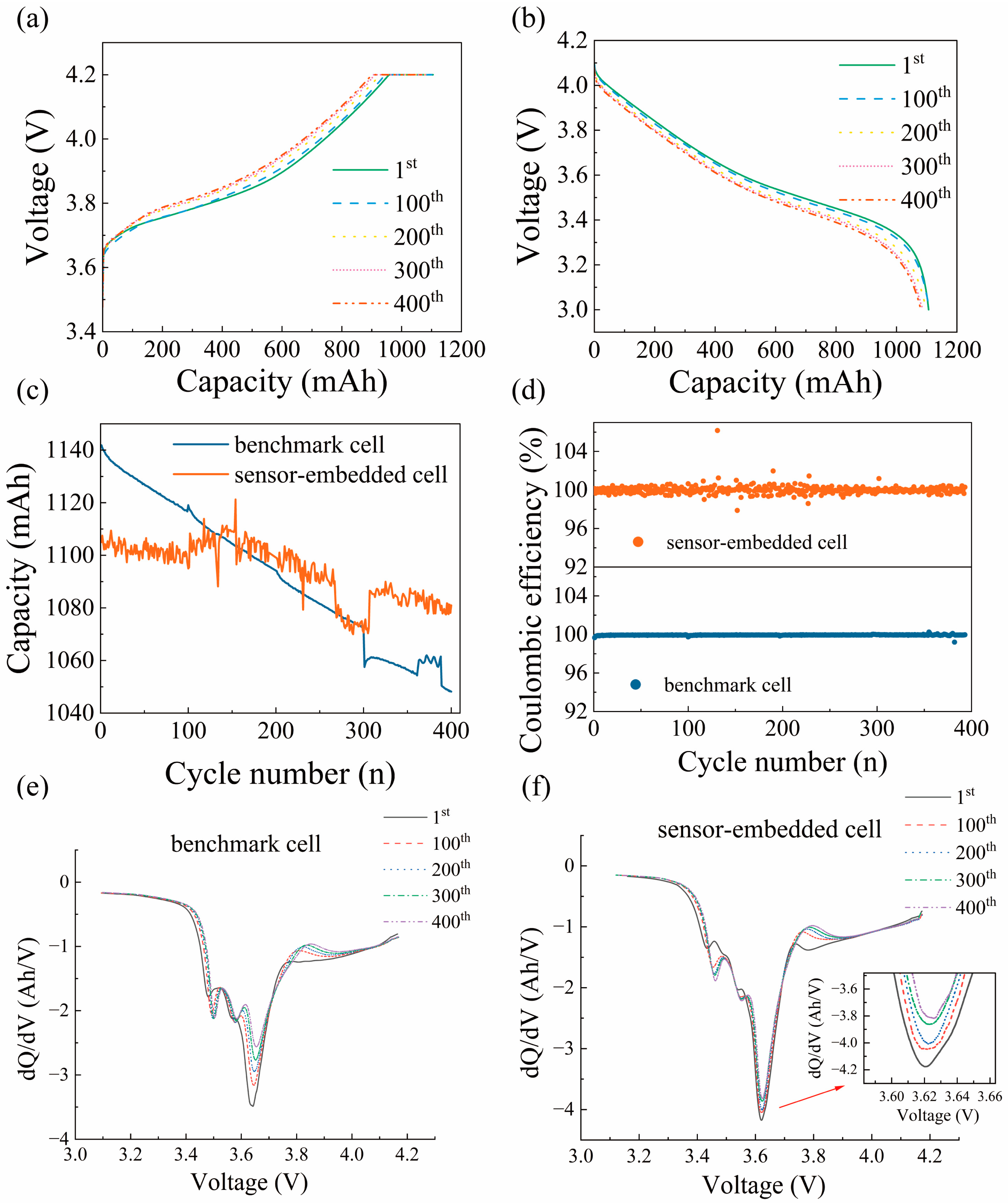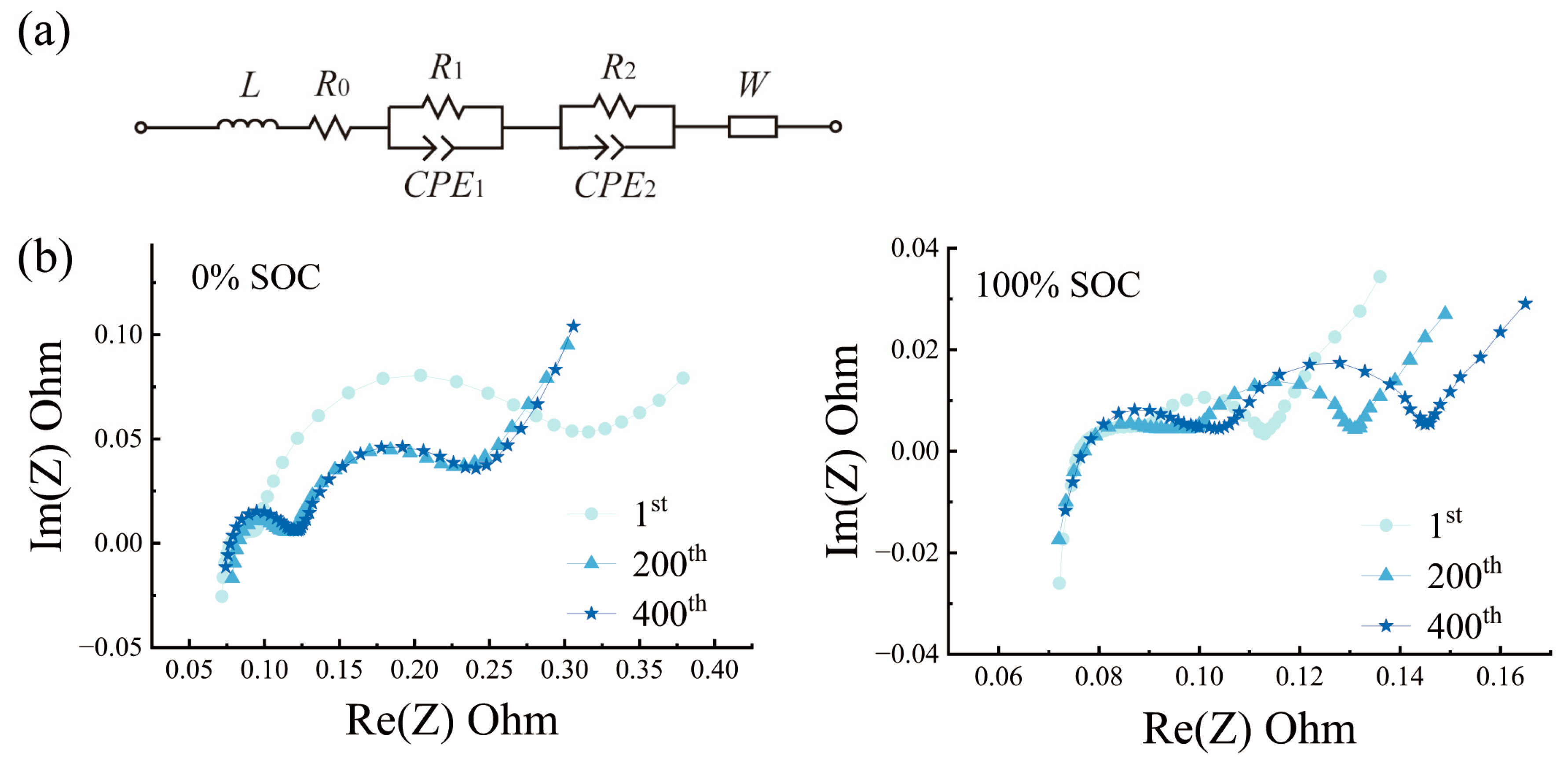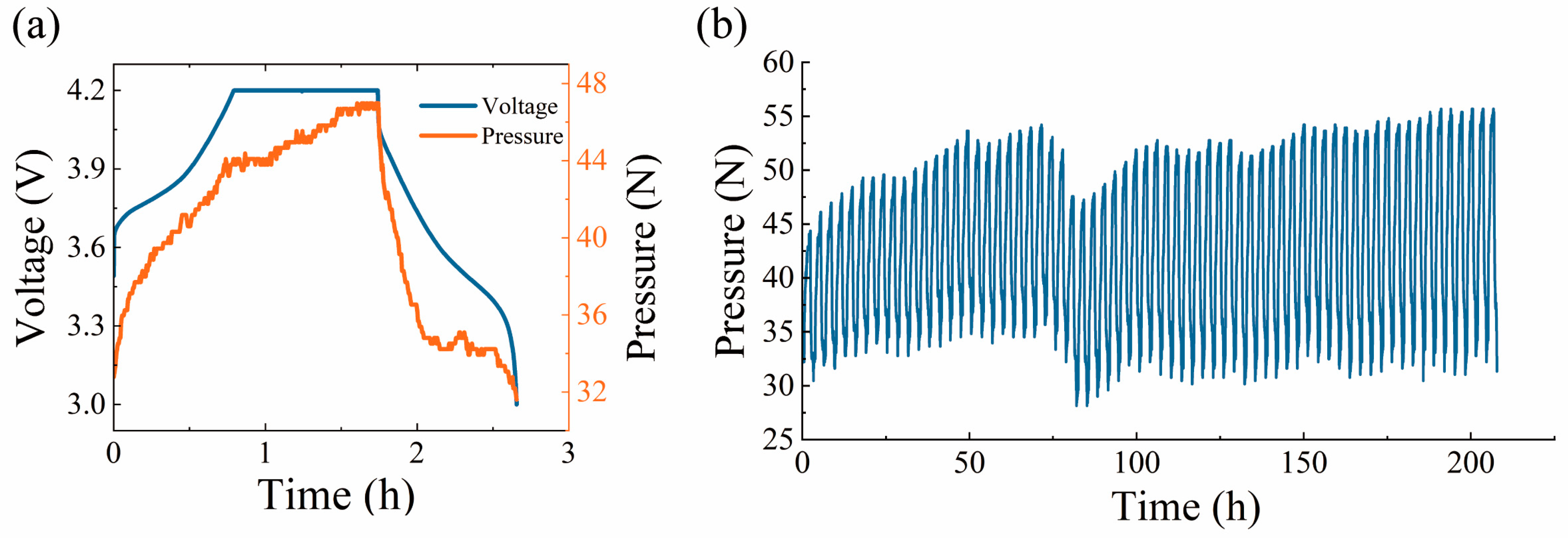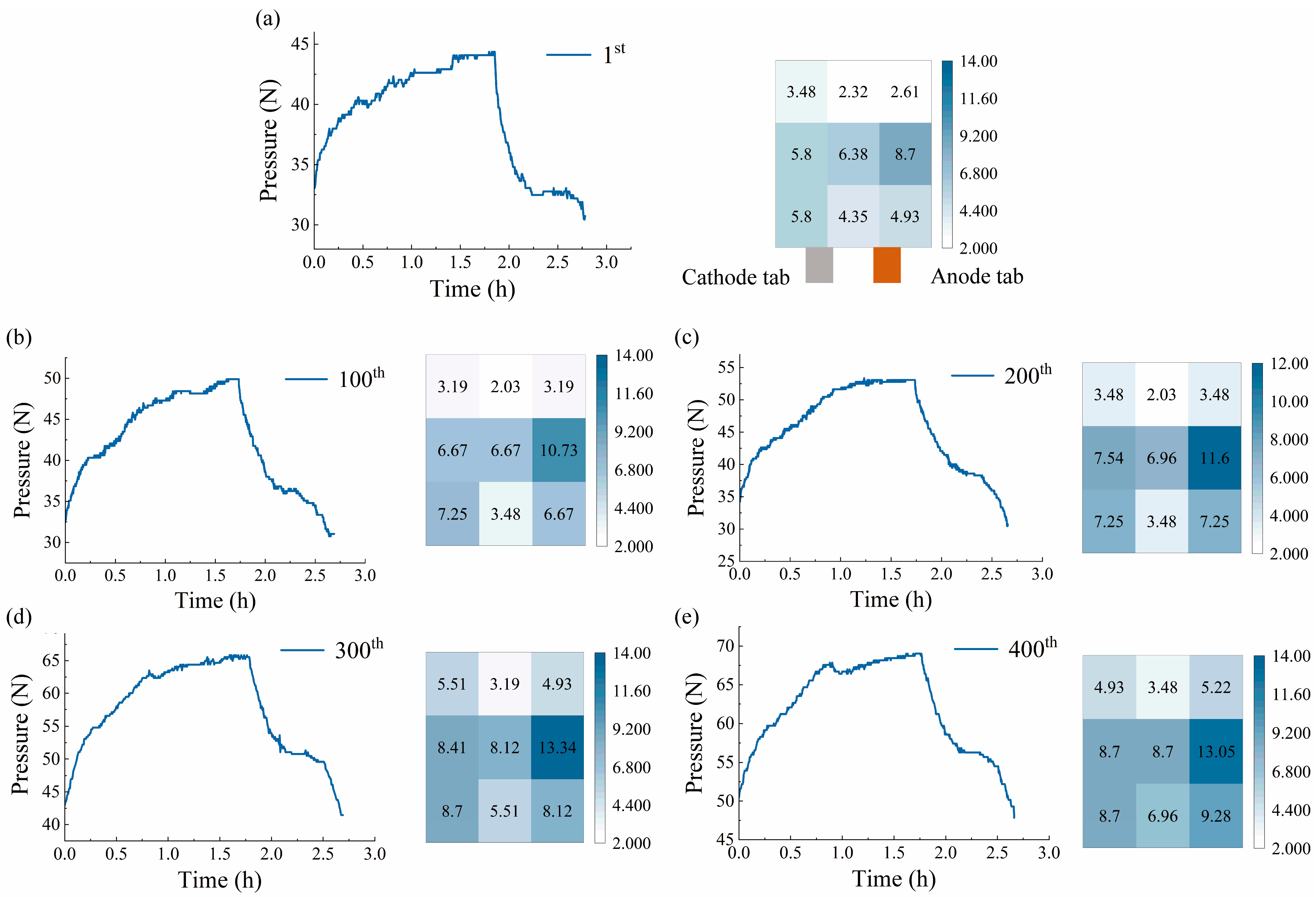Experimental Study on Distributed Measurement of Internal Pressure in Lithium-Ion Batteries Using Thin-Film Sensors
Abstract
1. Introduction
2. Materials and Methods
3. Results and Discussion
3.1. Cycling Test and Electrochemical Test Results of the Sensor-Embedded Battery
3.2. Distributed Pressure Change Monitoring Inside the Battery
4. Conclusions
Author Contributions
Funding
Data Availability Statement
Conflicts of Interest
Abbreviations
| LIBs | Lithium-ion batteries |
| IFE | Integrated functional electrode |
| EVs | Electric vehicles |
| BMS | Battery management system |
| SEI | Solid electrolyte interphase |
| SOH | State of health |
| EIS | Electrochemical impedance spectroscopy |
| SOC | State of charge |
| ECM | Equivalent circuit model |
References
- Ping, P.; Wang, Q.; Huang, P.; Sun, J.; Chen, C. Thermal behaviour analysis of lithium-ion battery at elevated temperature using deconvolution method. Appl. Energy 2014, 129, 261–273. [Google Scholar] [CrossRef]
- Xue, N.; Du, W.; Greszler, T.A.; Shyy, W.; Martins, J.R.R.A. Design of a lithium-ion battery pack for PHEV using a hybrid optimization method. Appl. Energy 2014, 115, 591–602. [Google Scholar] [CrossRef]
- Wen, J.; Zhao, D.; Zhang, C. An overview of electricity powered vehicles: Lithium-ion battery energy storage density and energy conversion efficiency. Renew. Energy 2020, 162, 1629–1648. [Google Scholar] [CrossRef]
- Zhu, Y.; Liu, C.; Yang, Y.; Li, Y.; Wu, Q.-H. A novel design of inorganic-polymer gel electrolyte/anode interphase in quasi-solid-state lithium-ion batteries. Electrochim. Acta 2023, 446, 142097. [Google Scholar] [CrossRef]
- Wan, S.; Ma, W.; Wang, Y.; Xiao, Y.; Chen, S. Electrolytes Design for Extending the Temperature Adaptability of Lithium-Ion Batteries: From Fundamentals to Strategies. Adv. Mater. 2024, 36, e2311912. [Google Scholar] [CrossRef]
- Schabenberger, T.; Kücher, S.; Aufschläger, A.; Jossen, A. Impact of applied and preceding pressure on performance and reversible swelling of lithium-ion pouch cells with varying microporous separators. J. Energy Storage 2024, 102, 113910. [Google Scholar] [CrossRef]
- Zhu, S.; Han, J.; An, H.-Y.; Pan, T.-S.; Wei, Y.-M.; Song, W.-L.; Chen, H.-S.; Fang, D. A novel embedded method for in-situ measuring internal multi-point temperatures of lithium ion batteries. J. Power Sources 2020, 456, 227981. [Google Scholar] [CrossRef]
- Waag, W.; Käbitz, S.; Sauer, D.U. Experimental investigation of the lithium-ion battery impedance characteristic at various conditions and aging states and its influence on the application. Appl. Energy 2013, 102, 885–897. [Google Scholar] [CrossRef]
- Peng, J.; Zhao, X.; Ma, J.; Meng, D.; Zhu, J.; Zhang, J.; Yan, S.; Zhang, K.; Han, Z. Enhancing lithium-ion battery monitoring: A critical review of diverse sensing approaches. eTransportation 2024, 22, 100360. [Google Scholar] [CrossRef]
- Jafaripour, H.; Sanaee, Z.; Mahdavi, H. Polymer-less electrospinning for realization of silica nanofibers membrane as a flexible separator with ultra-high electrolyte uptake, for high safety lithium ion batteries. J. Power Sources 2025, 631, 236237. [Google Scholar] [CrossRef]
- Zhou, J.; Qian, T.; Liu, J.; Wang, M.; Zhang, L.; Yan, C. High-Safety All-Solid-State Lithium-Metal Battery with High-Ionic-Conductivity Thermoresponsive Solid Polymer Electrolyte. Nano Lett. 2019, 19, 3066–3073. [Google Scholar] [CrossRef] [PubMed]
- Tapaskar, R.P.; Revankar, P.P.; Ganachari, S.V. Advancements in Battery Management Systems for Electric Vehicles: A MATLAB-Based Simulation of 4S3P Lithium-Ion Battery Packs. World Electr. Veh. J. 2024, 15, 222. [Google Scholar] [CrossRef]
- Nayfeh, Y.; Vittitoe, J.C.; Li, X. Quantifying the Aging of Lithium-Ion Pouch Cells Using Pressure Sensors. Batteries 2024, 10, 333. [Google Scholar] [CrossRef]
- Liu, X.M.; Arnold, C.B. Effects of Cycling Ranges on Stress and Capacity Fade in Lithium-Ion Pouch Cells. J. Electrochem. Soc. 2016, 163, A2501–A2507. [Google Scholar] [CrossRef]
- S, V.; Che, H.S.; Selvaraj, J.; Tey, K.S.; Lee, J.W.; Shareef, H.; Errouissi, R. State of Health (SoH) estimation methods for second life lithium-ion battery—Review and challenges. Appl. Energy 2024, 369, 123542. [Google Scholar] [CrossRef]
- Semeraro, C.; Caggiano, M.; Olabi, A.-G.; Dassisti, M. Battery monitoring and prognostics optimization techniques: Challenges and opportunities. Energy 2022, 255, 124538. [Google Scholar] [CrossRef]
- Xie, Y.; Wang, S.; Zhang, G.; Takyi-Aninakwa, P.; Fernandez, C.; Blaabjerg, F. A review of data-driven whole-life state of health prediction for lithium-ion batteries: Data preprocessing, aging characteristics, algorithms, and future challenges. J. Energy Chem. 2024, 97, 630–649. [Google Scholar] [CrossRef]
- Mei, W.; Duan, Q.; Lu, W.; Sun, J.; Wang, Q. An investigation on expansion behavior of lithium ion battery based on the thermal-mechanical coupling model. J. Clean. Prod. 2020, 274, 122643. [Google Scholar] [CrossRef]
- Aiello, L.; Ruchti, P.; Vitzthum, S.; Coren, F. Influence of Pressure, Temperature and Discharge Rate on the Electrical Performances of a Commercial Pouch Li-Ion Battery. Batteries 2024, 10, 72. [Google Scholar] [CrossRef]
- Chen, Z.; Lin, J.; Zhu, C.; Zhuang, Q.; Chen, Q.; Wei, Y.; Wang, S.; Wu, D. Detection of jelly roll pressure evolution in large-format Li-ion batteries via in situ thin film flexible pressure sensors. J. Power Sources 2023, 566, 232960. [Google Scholar] [CrossRef]
- Wünsch, M.; Kaufman, J.; Sauer, D.U. Investigation of the influence of different bracing of automotive pouch cells on cyclic liefetime and impedance spectra. J. Energy Storage 2019, 21, 149–155. [Google Scholar] [CrossRef]
- Uncovering the impact of pressure on lithium-metal pouch cells with liquid electrolytes. Nat. Energy 2024, 9, 518–519. [CrossRef]
- Meng, D.; Weng, J.; Wang, J. Experimental Investigation on Thermal Runaway of Lithium-Ion Batteries under Low Pressure and Low Temperature. Batteries 2024, 10, 243. [Google Scholar] [CrossRef]
- Perez Estevez, M.A.; Conte, F.V.; Tremonti, C.; Renzi, M. Aging estimation of lithium ion cells under real-world conditions through mechanical stress measurements. J. Energy Storage 2023, 64, 107186. [Google Scholar] [CrossRef]
- Cannarella, J.; Arnold, C.B. Stress evolution and capacity fade in constrained lithium-ion pouch cells. J. Power Sources 2014, 245, 745–751. [Google Scholar] [CrossRef]
- Zhu, Y.; Song, J.; Yan, L.; Guo, X.; Chen, J.; Zhao, C.; Huang, Y. Operando pressure measurements monitor the degradation of SiOx/C anode for Li-ion cells. J. Power Sources 2023, 588, 233711. [Google Scholar] [CrossRef]
- Wu, Y.; Zhu, S.; Wang, Z.; Zhou, P.; Xie, F.; Zhou, J.; Chen, H.-S.; Song, W.-L.; Fang, D. In-situ investigations of the inhomogeneous strain on the steel case of 18650 silicon/graphite lithium-ion cells. Electrochim. Acta 2021, 367, 137516. [Google Scholar] [CrossRef]
- Zhu, S.; Yang, L.; Wen, J.; Feng, X.; Zhou, P.; Xie, F.; Zhou, J.; Wang, Y.-N. In operando measuring circumferential internal strain of 18650 Li-ion batteries by thin film strain gauge sensors. J. Power Sources 2021, 516, 230669. [Google Scholar] [CrossRef]
- Shen, Y.; Wang, S.; Li, H.; Wang, K.; Jiang, K. An overview on in situ/operando battery sensing methodology through thermal and stress measurements. J. Energy Storage 2023, 64, 107164. [Google Scholar] [CrossRef]
- Mutyala, M.S.K.; Zhao, J.; Li, J.; Pan, H.; Yuan, C.; Li, X. In-situ temperature measurement in lithium ion battery by transferable flexible thin film thermocouples. J. Power Sources 2014, 260, 43–49. [Google Scholar] [CrossRef]
- Pickrell, G.; Udd, E.; Du, H.H.; Meyer, J.; Nedjalkov, A.; Doering, A.; Angelmahr, M.; Schade, W. Fiber optical sensors for enhanced battery safety. In Proceedings of the Fiber Optic Sensors and Applications XII, Baltimore, MD, USA, 22–23 April 2015. [Google Scholar]
- Ganguli, A.; Saha, B.; Raghavan, A.; Kiesel, P.; Arakaki, K.; Schuh, A.; Schwartz, J.; Hegyi, A.; Sommer, L.W.; Lochbaum, A.; et al. Embedded fiber-optic sensing for accurate internal monitoring of cell state in advanced battery management systems part 2: Internal cell signals and utility for state estimation. J. Power Sources 2017, 341, 474–482. [Google Scholar] [CrossRef]
- Miele, E.; Dose, W.M.; Manyakin, I.; Frosz, M.H.; Ruff, Z.; De Volder, M.F.L.; Grey, C.P.; Baumberg, J.J.; Euser, T.G. Hollow-core optical fibre sensors for operando Raman spectroscopy investigation of Li-ion battery liquid electrolytes. Nat. Commun. 2022, 13, 1651. [Google Scholar] [CrossRef]
- Yu, Y.; Vergori, E.; Maddar, F.; Guo, Y.; Greenwood, D.; Marco, J. Real-time monitoring of internal structural deformation and thermal events in lithium-ion cell via embedded distributed optical fibre. J. Power Sources 2022, 521, 230957. [Google Scholar] [CrossRef]
- Mei, W.; Liu, Z.; Wang, C.; Wu, C.; Liu, Y.; Liu, P.; Xia, X.; Xue, X.; Han, X.; Sun, J.; et al. Operando monitoring of thermal runaway in commercial lithium-ion cells via advanced lab-on-fiber technologies. Nat. Commun. 2023, 14, 5251. [Google Scholar] [CrossRef] [PubMed]
- Li, J.; Li, Y.; Zeng, W. Gas sensing technology as the key to safety warning of lithium-ion battery: Recent advance. Sens. Actuators A Phys. 2024, 365, 114890. [Google Scholar] [CrossRef]
- Xu, W.; Li, L.; Shi, F.; Chen, Q. Ultrasonic spectroscopy for in situ early detection and dynamic monitoring of lithium plating in lithium-ion batteries. Cell Rep. Phys. Sci. 2025, 6, 102507. [Google Scholar] [CrossRef]
- Wang, X.; Zhu, J.; Wei, X.; Wang, D.; Xu, W.; Jin, Y.; Dai, H. Non-damaged lithium-ion batteries integrated functional electrode for operando temperature sensing. Energy Storage Mater. 2024, 65, 103160. [Google Scholar] [CrossRef]
- Heiskanen, S.K.; Kim, J.; Lucht, B.L. Generation and Evolution of the Solid Electrolyte Interphase of Lithium-Ion Batteries. Joule 2019, 3, 2322–2333. [Google Scholar] [CrossRef]
- Guo, J.; Li, Y.; Meng, J.; Pedersen, K.; Gurevich, L.; Stroe, D.-I. Understanding the mechanism of capacity increase during early cycling of commercial NMC/graphite lithium-ion batteries. J. Energy Chem. 2022, 74, 34–44. [Google Scholar] [CrossRef]
- Barai, A.; Tangirala, R.; Uddin, K.; Chevalier, J.; Guo, Y.; McGordon, A.; Jennings, P. The effect of external compressive loads on the cycle lifetime of lithium-ion pouch cells. J. Energy Storage 2017, 13, 211–219. [Google Scholar] [CrossRef]
- Wang, X.; Zhu, J.; Dai, H.; Yu, C.; Wei, X. Impedance Investigation of Silicon/Graphite Anode during Cycling. Batteries 2023, 9, 242. [Google Scholar] [CrossRef]
- Li, W.; Chen, J.; Quade, K.; Luder, D.; Gong, J.; Sauer, D.U. Battery degradation diagnosis with field data, impedance-based modeling and artificial intelligence. Energy Storage Mater. 2022, 53, 391–403. [Google Scholar] [CrossRef]
- Louli, A.J.; Li, J.; Trussler, S.; Fell, C.R.; Dahn, J.R. Volume, Pressure and Thickness Evolution of Li-Ion Pouch Cells with Silicon-Composite Negative Electrodes. J. Electrochem. Soc. 2017, 164, A2689–A2696. [Google Scholar] [CrossRef]
- Zhou, M.; Liao, Y.; Li, L.; Xiong, R.; Shen, G.; Chen, Y.; Huang, T.; Li, M.; Zhou, H.; Zhang, Y. Unraveling the heterogeneity of solid electrolyte interphase kinetically affecting lithium electrodeposition on lithium metal anode. J. Energy Chem. 2023, 85, 181–190. [Google Scholar] [CrossRef]
- Niu, C.; Lee, H.; Chen, S.; Li, Q.; Du, J.; Xu, W.; Zhang, J.-G.; Whittingham, M.S.; Xiao, J.; Liu, J. High-energy lithium metal pouch cells with limited anode swelling and long stable cycles. Nat. Energy 2019, 4, 551–559. [Google Scholar] [CrossRef]
- Arévalo, C.P.; Lata, G.J.; Francisco, J. Optimization of an Off-Grid Hybrid System Using Lithium Ion Batteries. Acta Polytech. Hung. 2020, 17, 185–206. [Google Scholar]






| 1st-0% | 200th-0% | 400th-0% | 1st-100% | 200th-100% | 400th-100% | |
|---|---|---|---|---|---|---|
| R0 | 0.06599 | 0.07236 | 0.07026 | 0.07180 | 0.06927 | 0.06225 |
| R1 | 0.02555 | 0.04573 | 0.05130 | 0.02476 | 0.02972 | 0.04420 |
| R2 | 0.16825 | 0.10364 | 0.10721 | 0.01537 | 0.03068 | 0.03673 |
Disclaimer/Publisher’s Note: The statements, opinions and data contained in all publications are solely those of the individual author(s) and contributor(s) and not of MDPI and/or the editor(s). MDPI and/or the editor(s) disclaim responsibility for any injury to people or property resulting from any ideas, methods, instructions or products referred to in the content. |
© 2025 by the authors. Published by MDPI on behalf of the World Electric Vehicle Association. Licensee MDPI, Basel, Switzerland. This article is an open access article distributed under the terms and conditions of the Creative Commons Attribution (CC BY) license (https://creativecommons.org/licenses/by/4.0/).
Share and Cite
Liu, Q.; Wang, X.; Zhu, J.; Jiang, G.; Wei, X.; Dai, H. Experimental Study on Distributed Measurement of Internal Pressure in Lithium-Ion Batteries Using Thin-Film Sensors. World Electr. Veh. J. 2025, 16, 270. https://doi.org/10.3390/wevj16050270
Liu Q, Wang X, Zhu J, Jiang G, Wei X, Dai H. Experimental Study on Distributed Measurement of Internal Pressure in Lithium-Ion Batteries Using Thin-Film Sensors. World Electric Vehicle Journal. 2025; 16(5):270. https://doi.org/10.3390/wevj16050270
Chicago/Turabian StyleLiu, Qingyun, Xiuwu Wang, Jiangong Zhu, Guiwen Jiang, Xuezhe Wei, and Haifeng Dai. 2025. "Experimental Study on Distributed Measurement of Internal Pressure in Lithium-Ion Batteries Using Thin-Film Sensors" World Electric Vehicle Journal 16, no. 5: 270. https://doi.org/10.3390/wevj16050270
APA StyleLiu, Q., Wang, X., Zhu, J., Jiang, G., Wei, X., & Dai, H. (2025). Experimental Study on Distributed Measurement of Internal Pressure in Lithium-Ion Batteries Using Thin-Film Sensors. World Electric Vehicle Journal, 16(5), 270. https://doi.org/10.3390/wevj16050270








